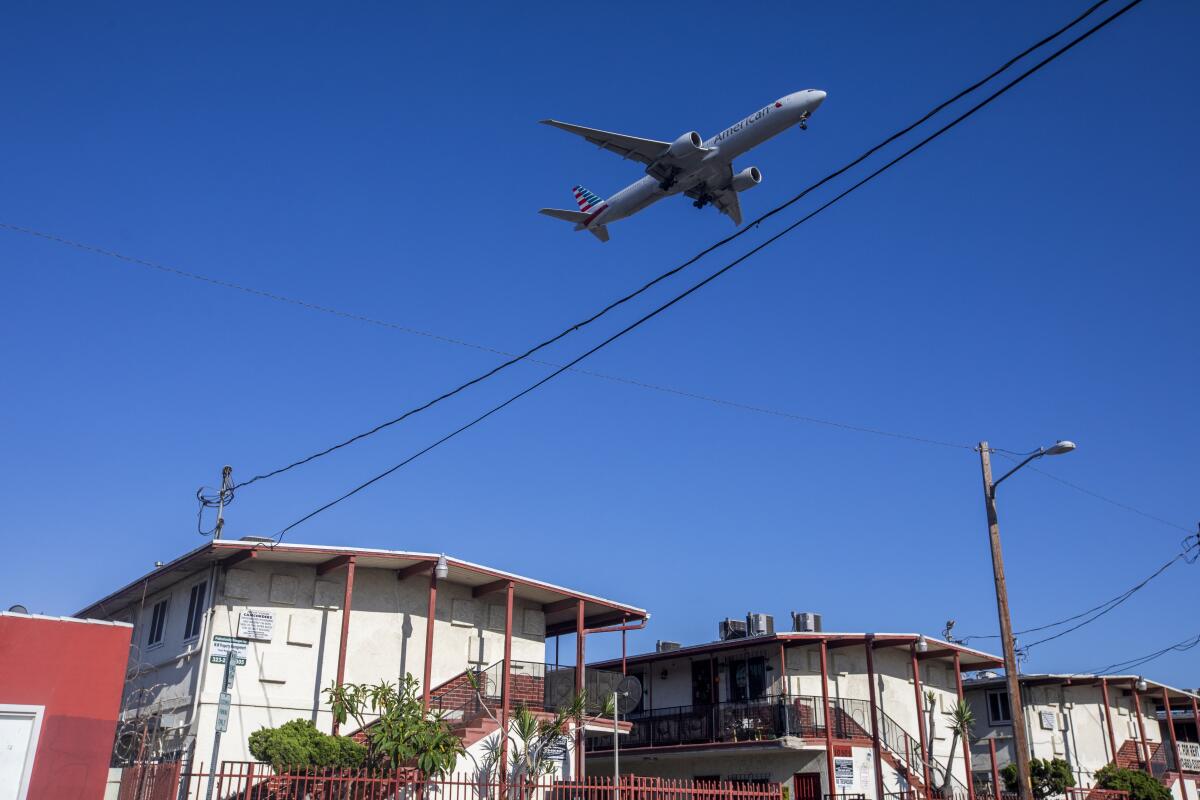Relief to residents: FAA announces $20.5 million to soundproof homes near LAX

- Share via
Thursday morning in Lennox began quietly: birds chirping, the soft brush of a woman sweeping the pavement, cars whooshing by.
And then, a roar. A minute or two later, another one.
Residents went on with their daily routines, seemingly oblivious to their loud neighbor: Los Angeles International Airport.
“I’m so used to it,” said 28-year-old Jazmin Gonzalez, who has lived in Lennox her whole life. “If I don’t see airplanes, I am not close to home.”
Airplane noise accompanies daily life in the neighborhoods surrounding LAX.
But some residents could soon catch a break, thanks to a $20.5-million grant this month from the Federal Aviation Administration to mitigate airport noise for more than 1,300 households in the cities of El Segundo, Los Angeles and Inglewood, as well as unincorporated parts of Los Angeles County including Del Aire, Athens and Lennox.
The grants — about $6 million for Los Angeles and El Segundo, $5 million for Inglewood and $9 million for the unincorporated communities — will go toward soundproof windows and doors, as well as air conditioning systems, according to the FAA.
Qualifying property owners, who must have their buildings sound-tested, will each receive about $40,000 in upgrades.
Only non-soundproofed homes that are up to code and endure an annual average noise level of 65 decibels or higher, based on an FAA-approved noise map, are eligible, according to Heath Montgomery, director of public relations for Los Angeles World Airports.
“LAX is the world’s third busiest airport, a plane lands once every minute,” L.A. County Supervisor Holly Mitchell, whose district includes LAX, said in a written statement. “As we celebrate our region’s immense draw, we must also take into account that for our communities near the airport, plane traffic is a quality-of-life issue.”
Airplane noise has long dogged people living near busy airports such as LAX, Hollywood Burbank and John Wayne in Santa Ana. Residents often crowd community meetings to request different flight routing options and limits to noise pollution.
Others don’t mind the sound, considering it a built-in attribute of home.
“It’s kind of like blinking. When you bring attention to it, you’re kind of aware you’re blinking,” said Adam Rosas, 21, an Inglewood resident for more than 10 years. “If I’m minding my own business, it’s not really a problem.”
The July allocation is the latest round of FAA money to mitigate noise in the LAX area.
In a soundproofing program that ran from 1997 to 2014, 89% of eligible L.A. property owners agreed to have their homes soundproofed, Montgomery said.
More than 7,000 homes in Inglewood have already been soundproofed, including 69-year-old Asuncion Reynoso’s one-story house a couple of miles from the airport.
Reynoso said a similar program about 10 years ago outfitted his home of more than 30 years with thick windows and air conditioning, which helps keep the noise at a comfortable level.
As he spoke outside, he was twice interrupted by the deafening thunder of planes overhead.
“You get used to noise. Some people when they come visit, they say, ‘Oh,’” Reynoso said, imitating his guests’ grimaces.
They shouldn’t be surprised, he said — it comes with living near the airport.
A Times analysis from 2019 found that in previous rounds of soundproofing grants in Inglewood, middle-class, single-family neighborhoods on the city’s east side disproportionately receive funding — at least in part because of tricky zoning preventing improvements closer to the airport.
Mayor James Butts said the lower-income neighborhoods closer to the airport are also filled with rental properties whose landlords don’t keep the places up to code — a requirement to receive the FAA grants.
He said he is working to ensure that every building that meets the criteria is soundproofed.
More to Read
Sign up for Essential California
The most important California stories and recommendations in your inbox every morning.
You may occasionally receive promotional content from the Los Angeles Times.











